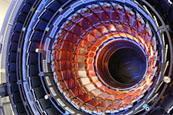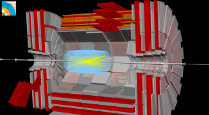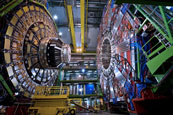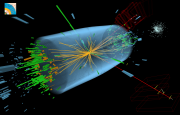High school students use cutting-edge tools to do scientific investigations.
 Real Event
Superimposed on Detector |
At CERN near Geneva, Switzerland, the Large Hadron Collider (LHC) collides protons at the highest energies ever achieved in the laboratory to reveal new knowledge about matter and energy. Giant detectors make careful measurements from the collisions. One of these detectors is CMS, the Compact Muon Solenoid. Physicists working on CMS and its sister detector, ATLAS, first calibrated their experiments by rediscovering the particles of the Standard Model. They added to that picture in 2012 with the discovery of the Higgs boson, the long-sought key to understanding the masses of fundamental particles. Yet physicists know that the Standard Model does not explain everything. The search for new physics continues beyond the Standard Model. CMS e-Lab Student Home provides a guide with resources to create a research project, access to authentic CMS data and analysis tools for conducting that research, and ways to collaborate. The Teacher Home has learner objectives, assessment rubrics, standards, management tools, and more. Join our learning community built around the CMS e-Lab and the QuarkNet CMS data thread as we probe the physics uncovered by CMS. What are the elementary constituents of matter? What are the fundamental forces that control their behavior at the most basic level? Information common for all e-LabsCheck out our online resources
|






